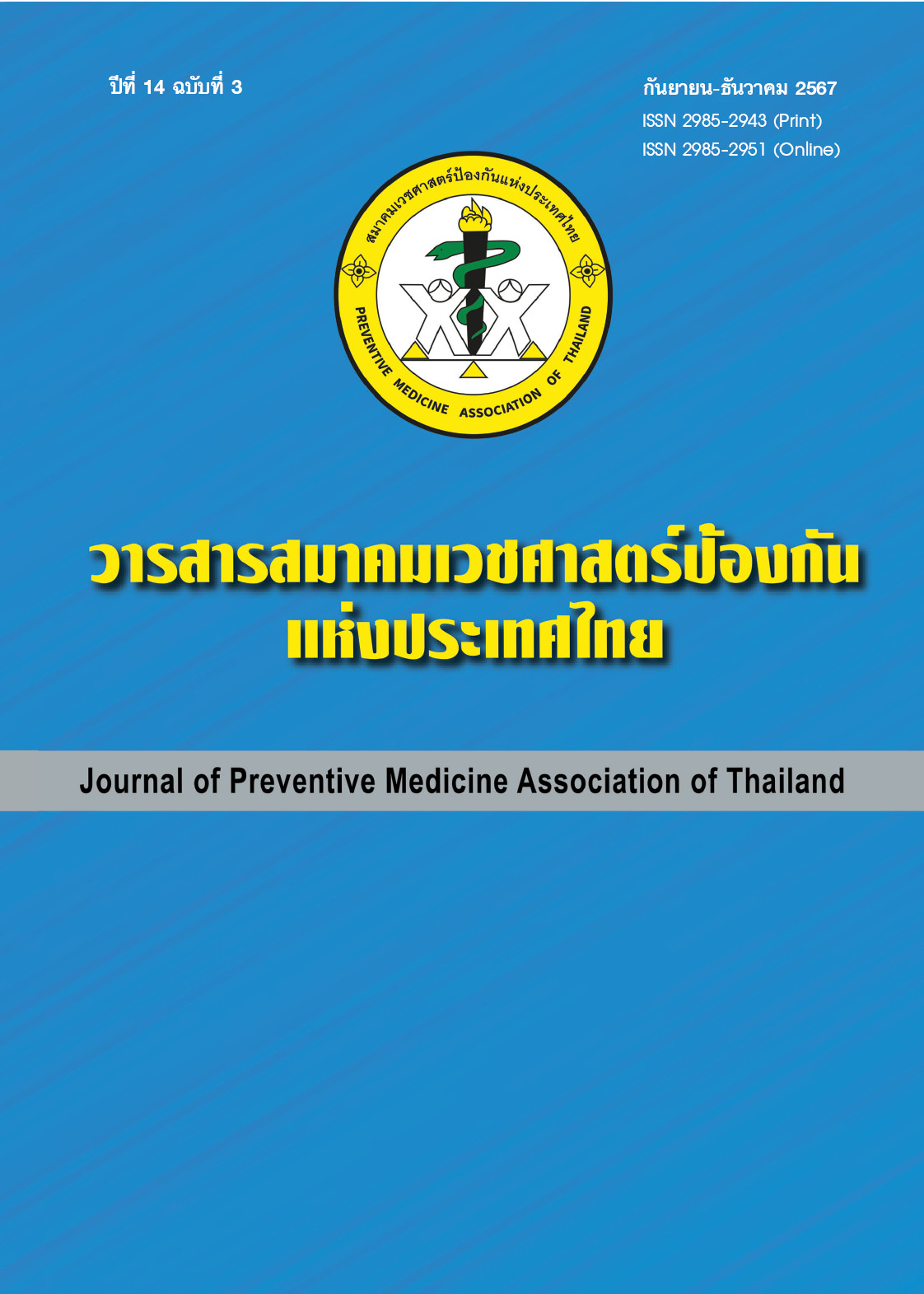Associations Between Sociodemographic Factors and Diabetes Incidence: A Retrospective Nationwide Cohort Study
Keywords:
Incidence, Diabetes, Sociodemographic, ThailandAbstract
Objectives: This study is to calculate diabetes incidence in the Thai population and identify associations between sociodemographic factors and diabetes incidence. People aged 20 and over who had not previously received a diabetes diagnosis from Thai National Health Examination Survey V (NHES V) and used public health services registered with the National Health Security Office Database were included in the study. Methods: The Cox proportional hazards model was used for identifying the associations. The study included 10,203 participants, categorized into three groups based on their blood sugar level at the start of the cohort: 1. normal blood sugar level; 2. prediabetes; and 3. suspected diabetes—a total of 7,482, 2,185, and 536 people, respectively. Results: In the 7-year follow-up from 2013 to 2020, there were 769 newly diagnosed diabetes patients, representing an incidence of 10.6 (95% CI 9.8–11.4) per 1,000 population years. Sociodemographic factors associated with diabetes incidence were the southern region (adjusted HR 0.74, p=0.02; Ref: central region) and highest educational attainment (adjusted HR 0.69, p=0.01; 0.74, p=0.01; and 0.70, p=0.04 for lower secondary, higher secondary, and bachelor’s degree and above, respectively; Ref: primary level). Conclusions: This study showed that the population residing in the southern region and those who completed at least secondary education had fewer chances of developing diabetes compared to their counterparts.
References
World Health Organization. Global report on diabetes [Internet]. 2016 [cited 2024 Jun 7]. Available from: https://shorturl.asia/5gkfC
Guariguata L, Whiting DR, Hambleton I, Beagley J, Linnenkamp U, Shaw JE. Global estimates of diabetes prevalence for 2013 and projections for 2035. Diabetes Res Clin Pract. 2014 ;103(2):137–49.
International Diabetes Federation. IDF Diabetes Atlas. 8th ed. Brussels: International Diabetes Federation; 2017.
วิชัย เอกพลากร, บรรณาธิการ. การสำรวจสุขภาพประชาชนไทยโดยการตรวจร่างกายครั้งที่ 4 พ.ศ.2551-2552. นนทบุรี: สำนักงานสำรวจสุขภาพประชาชนไทย สถาบันวิจัยระบบสาธารณสุข; 2554.
วิชัย เอกพลากร, บรรณาธิการ. การสำรวจสุขภาพประชาชนไทยโดยการตรวจร่างกาย ครั้งที่ 6 พ.ศ. 2562-2563. กรุงเทพฯ: คณะแพทยศาสตร์โรงพยาบาลรามาธิบดี มหาวิทยาลัยมหิดล; 2564.
United Nations. World Population Prospects 2022: Summary of results. New York: United Nations; 2022.
Emerging Risk Factors Collaboration. Diabetes mellitus, fasting blood glucose concentration, and risk of vascular disease: a collaborative meta-analysis of 102 prospective studies. Lancet 2010;375(9733):2215–22.
Paengsai N, Jourdain G, Chaiwarith R, Tantraworasin A, Bowonwatanuwong C, Bhakeecheep S, et al. Incidence and clinical outcomes of diabetes mellitus in HIV-infected adults in Thailand: a retrospective cohort study. BMC Public Health 2018;18(1079):1-10.
Kittithaworn A, Dy R, Hatthachote P, Rangsin R, Mungthin M, Narindrarangkura P, et al. Incidence and associated factors of type 2 diabetes: a community-based cohort study in the central region of rural community in Thailand. Asia Pac J Public Health 2019;31(1):72–83.
Jiamjarasrangsi W, Aekplakorn W. Incidence and predictors of type 2 diabetes among professional and office workers in Bangkok, Thailand. J Med Assoc Thai 2005;88(12):1896-904.
Charoensri S, Turnsaket S, Pongchaiyakul C. Hypertriglyceridemia as an independent predictor for ten-year incidence of diabetes in Thais. Vasc Health Risk Manag 2021;17:519–25.
Papier K, Jordan S, D‘Este C, Bain C, Peungson J, Banwell C, et al. Incidence and risk factors for type 2 diabetes mellitus in transitional Thailand: results from the Thai cohort study. BMJ Open 2016;6(12):e014102.
SDG Move Team. SDG Insights คนจนในกรุงเทพฯ และโอกาสทางสุขภาพ: การพัฒนาระบบบริการปฐมภูมิ [อินเทอร์เน็ต]. 2022 [เข้าถึงเมื่อ 4 มิ.ย. 2567]. เข้าถึงได้จาก: https://www.sdgmove.com/2022/05/21/sdg-insights-primary-care-accessibility-in-bangkok/
วิชัย เอกพลากร, ลัดดา เหมาะสุวรรณ, นิชรา เรืองดารกานนท์, วราภรณ์ เสถียรนพเกล้า, หทัยชนก พรรคเจริญ. การสำรวจสุขภาพประชาชนไทยโดยการตรวจร่างกายครั้งที่ 5 พ.ศ. 2557. นนทบุรี: สถาบันวิจัยระบบสาธารณสุข; 2559.
สำนักบริหารการทะเบียน กรมการปกครอง. สถิติประชากรทางการทะเบียนราษฎร [อินเทอร์เน็ต]. [เข้าถึงเมื่อ 28 ต.ค. 2567]. เข้าถึงจาก: https://stat.bora.dopa.go.th/stat/statnew/statMONTH/statmonth/#/view
กระทรวงสาธารณสุข. อัตราป่วยรายใหม่ของโรคเบาหวานต่อแสนประชากรในปีงบประมาณ [อินเทอร์เน็ต]. [เข้าถึงเมื่อ 28 ต.ค. 2567]. เข้าถึงจาก: https://shorturl.asia/g2YQx
Hill-Briggs F, Adler NE, Berkowitz SA, Chin MH, Gary-Webb TL, Navas-Acien A, et al. Social determinants of health and diabetes: a scientific review. Diabetes Care 2020;44:258–79.
van der Heide I, Wang J, Droomers M, Spreeuwenberg P, Rademakers J, Uiters E. The relationship between health, education, and health literacy: results from the Dutch Adult Literacy and Life Skills Survey. J Health Commun 2013;18:172–84.
Kuddus MA, Tynan E, McBryde E. Urbanization: a problem for the rich and the poor? Public Health Rev 2020;41(1):1-4.
Hyun MK, Park JH, Kim KH, Ahn SK, Ji SM. Incidence and risk factors for progression to diabetes mellitus: a retrospective cohort study. Int J Environ Res Public Health 202123;19(1):123.
Kim MJ, Lim NK, Choi SJ, Park HY. Hypertension is an independent risk factor for type 2 diabetes: the Korean genome and epidemiology study. Hypertension Research 2015;38:783-89.
Downloads
Published
How to Cite
Issue
Section
License
Copyright (c) 2024 สมาคมเวชศาสตร์ป้องกันแห่งประเทศไทย

This work is licensed under a Creative Commons Attribution-NonCommercial-NoDerivatives 4.0 International License.
บทความที่ลงพิมพ์ในวารสารเวชศาสตร์ป้องกันแห่งประเทศไทย ถือเป็นผลงานวิชาการ งานวิจัย วิเคราะห์ วิจารณ์ เป็นความเห็นส่วนตัวของผู้นิพนธ์ กองบรรณาธิการไม่จำเป็นต้องเห็นด้วยเสมอไปและผู้นิพนธ์จะต้องรับผิดชอบต่อบทความของตนเอง






